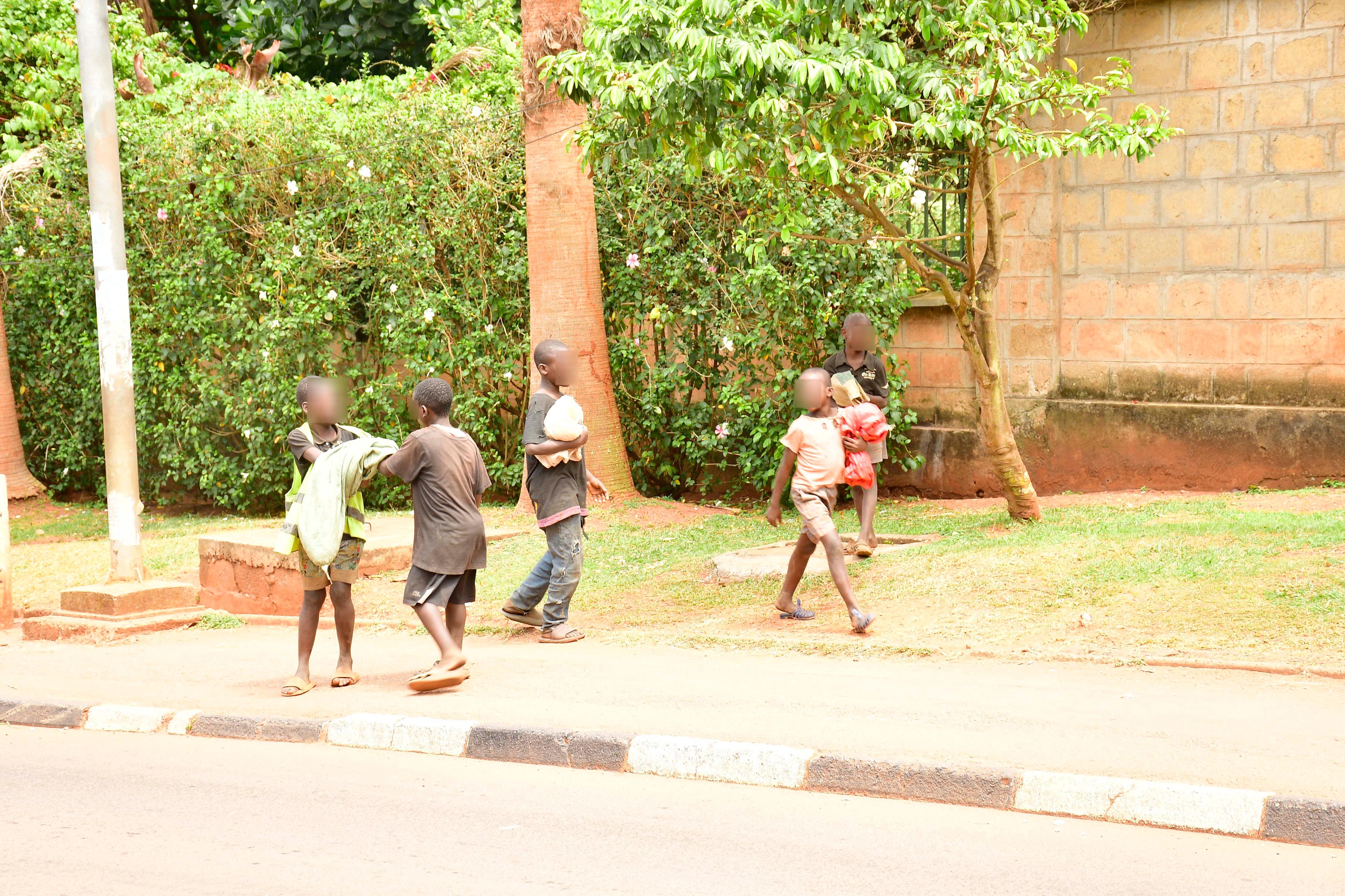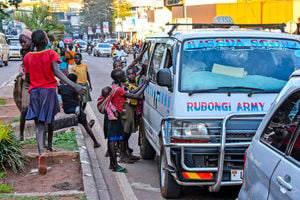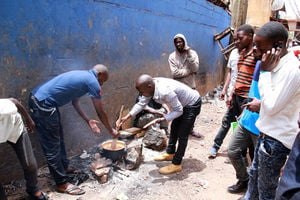
Street children on Wampewo Avenue in Kampala. PHOTO | STEPHEN OTAGE
“Government to spend Shs3b to get children off streets,” screamed a headline in this newspaper on March 19, 2019, the announcement made by then State Minister for Youth and Children Affairs, Ms Florence Nakiwala Kiyingi.
The money would be spent on multi-sectoral swoop operations involving her Gender ministry, Kampala Capital City Authority (KCCA), police, and local governments to rid Kampala and other major towns of children begging on the streets.
Eight months later on October 23, 2019, she told a media briefing in Kampala that Cabinet had approved Shs5.8b strategic plan of removing children from streets, rehabilitating, and resettling them to their areas of origin.
Of the Shs3.4b requested in March, Ms Nakiwala, who was dropped as minister in July 2021 and made senior presidential advisor on Gender and Youth Affairs, revealed that only Shs1b had been released by the Ministry of Finance, leaving a balance of Shs2.4b which limited implementation of the work plan to only Kampala.
The Gender ministry, as the main coordinating agency, according to an implementation action plan, then signed memorandum of understandings (MoUs) cleared by the Solicitor General to ensure compliance, with several agencies and NGOs.
These included: KCCA for street surveillance, withdraw, advocacy, and demolition of temporary shelters in Kisenyi and Katwe; police, for surveillance in Kampala and along routes to Kampala, support KCCA and evacuation of children at risk, arrest and prosecution of perpetrators; Napak Local Government, for community sensitisation; Uganda Women’s Efforts to Save Orphans (UWESO), for rehabilitation, tracing and resettlement of unaccompanied children; Federation of Uganda Football Associations (FUFA), for rehabilitation of children interested in football; Kobulin Youth Skills Centre for repatriation, rehabilitation and reintegration of children in Karamoja; and Institute of International Cooperation and Development, for supporting the Kobulin Youth Skills Training Centre.
The swoop operation netted 585 children and 139 adults, from Old Kampala, Katwe-Kikaramoja zone- Kampala Central, Kisugu-Go down, and Wandegeya. Of the group, 220 were Karimojong children and 504 non-Karimojong children and adults. The children were screened at Kampiringisa, and subsequently taken to UWESO rehabilitation home in Masulita, among other places. Some children were reunited with their parents, and others escaped.
Out of the Shs1b, KCCA received Shs258m, with Shs65.2m spent on 24-hour street surveillance, Shs46m on picking children off the streets, Shs30m on closure of temporary shelters, Shs62.7m on repatriations to Karamoja, Shs35m on media campaigns, and Shs18.6m on rescue meetings.
Police got Shs76.6m, of which Shs30.9m was spent on surveillance along target points in Kampala and Shs45.7m on evacuation of at-risk children. Napak District Local Government received Shs38.9m, out of which Shs17m was spent on community sensitisation, Shs10.5m on surveillance of routes, Shs8m on advocacy, and Shs3m on coordination. UWESO received Shs31m with Shs28.2m spent on food and nonfood items.
Fufa received Shs201m to buy food and train the children with football skills. Kobulin got Shs94m, while the Gender ministry received Shs208m, with Shs33.6m spent on advocacy, Shs16m on coordination, Shs17m on monitoring activities, and Shs9.3m on transporting the children to Napak.
Even as the Gender ministry decried the release of only Shs1b out of the targeted Shs3.4b, the ministry’s own policy documents detail the imprudence of the plan against backdrop of lack of sustained street children interventions to avoid reoccurrence, and the need to formulate and enforce laws that slap penalties for parents allowing their children to live on the streets to beg, and the children themselves.
According to investigations by this newspaper, particularly Police and KCCA continue to conduct night swoop operations in Kikaramoja-Katwe, a Kampala City suburb, to round up street children for rehabilitation and return them back to Karamoja, particularly to Napak District.
It remains unclear about who authorises these operations, but they are meant to supply street children to several public and private rehabilitation homes to justify funding from all sources. The zinger is that the children are temporarily held at the homes before being repatriated to their origins, only to return to the streets, a pattern well-known to authorities.
One of such homes is the UWESO village in Masulita, which was predominately for rehabilitating orphans, but lately KCCA allegedly dumps street children there.
The UWESO chief executive officer, Ms Jolly Kaguhangire, acknowledged that KCCA operations have been bringing an average of 100 children to the facility.
“Street children are increasing. So we ended up finding ourselves helping the street kids, not specifically orphans,” she said.
However, the operations have particularly heighted unease among the majority-Karamojong inhabited settlements characterised by poor living conditions. Some of the beggars on Kampala’s streets live here. However, even non-beggars who eke a living by engaging in genuine economic activities such as collecting water bottles or winnowing grain in Owino market are routinely targeted.
Police referred to the Gender ministry for a comment while KCCA was not readily available for a comment.
A Gender ministry official, who requested anonymity, acknowledged the mostly at-the crack-of dawn swoop operations to rescue mainly children who are sent to the streets by their parents to beg. The official obliquely admitted to smaller amounts of monies signed off for the operations and their imprudence since many of the children return to the streets or transfer to other urban centres.
Also, of specific concern is the dehumanising manner in which these sweeps are carried out by the authorities.
This leaves those subjected to it, such asChristine Nakut, traumatised.
Nakut, a resident of Kikaramoja-Katwe, said: “When the police came they found us asleep. I was in the house with my children and siblings. I told the officer who asked for the whereabouts of my husband that he was away preaching, as he is a pastor. He told us to leave the house. I refused, then a female officer took my child and I followed her outside.”
Recounting the night of the raid in January, from her rented single roomed mud and wattle abode perched on the edge of a drainage channel in Kikaramoja slum in Katwe, Nakut revealed that she was among 80 women with children from Katwe driven that night to the UWESO Children’s village in Masulita.
“When we got to Masulita, they told us they were going to Luzira with our children but when we were driven to Luzira we left our children behind.”
Nakut’s two children remain in Masulita six months later and she has not seen them since. She was among the more than 80 women who pleaded guilty before the KCCA Magistrate’s Court for sending her children to the streets to beg in contravention of the 2022 Child Protection Ordinance, and was sentenced to community service, which she served in Napak before returning to Kampala.
“I stayed in Matany (Napak) during the whole of March waiting for the aid and support we were promised. There was nothing to eat amidst a general food scarcity, so I borrowed some money and returned to Kampala,” she said.
Booming business
The woe and torment the night raids have exacted on Nakut is a common experience in this community. Daily Monitor talked to several women with similar experiences. In other instances, many children have been missing for months to years, while parents fear to report cases to the police where they claim that they are treated with suspicion.
For the total combating of urchins at every turn and busy intersection in Kampala, Jinja, Iganga, Mbale, Busia and Lira, the ministry charted Shs5.8b plan; Shs226.6m for sweep operations, Shs2.5b for rehabilitation, feeding and skills training, Shs432m for tracing and resettlement, Shs275m for coordination of activities, and Shs2.3b for spending on preventive measures.
In an interview, the Commissioner for Youth and Gender Affairs in the ministry, Mr Fred Ngabirano, said it only dawned on them last year that “we cannot keep in this kind of exercise.”
“We analysed the past performance. We said, no, we can’t keep like this,” Mr Ngabirano said, a tacit admission of the failure of the strategy for which millions of shillings is spent periodically, adding: “So as a ministry, we decided to take lead in a coming up with a national programme to address the street children. With three thematic areas. One is prevention. Two, is withdrawal from the streets not only in Kampala but all cities, municipalities, even the trading centres, and then three, we do rehabilitation; we have come to believe that those who are still interested in going back to school, and they are aged below 15 years, we take them straight away back to schools.”
To the contrary, the Auditor General John Muwanga’s report for the audit year 2022 details that the Gender ministry does not “regularly carry out activities to control and manage street children by identifying gaps and suggesting recommendations towards eliminating them and improving their welfare.”
For instance, during that year, whereas the ministry put estimates of street children to around 1,000, only 292 could be accounted for leaving 708 children untraceable. Authorities in Napak and in Kampala acknowledged that majority of the children routinely removed from the streets go back, often by shuffling from one urban centre to another.
That year, the ministry budgeted spending Shs142m on operations of combating street children, of which only Shs44m was used, Mr Muwanga noted but there is no measure of impact for the monies spent.
One of the new strategies devised by Napak Local Government, to cater for the more than 300 children who were removed from the streets early this year in the sprucing up of the city in preparation for the back-to-back Non-Alignment Movement (NAM) and Third South Summits, was immediate intitutionalising all children of school-going age in boarding for at least three years without getting holidays.
In going back to the drawing board, Mr Ngabirano revealed plans of unveiling a five-year national programme for addressing street children and women with an estimated financial implication of Shs26b.
“We want to focus on skilling those who have dropped out of school. And then now, we are soon opening the newly-innovated Mubuku Skilling Centre in western, Uganda. And also, we want to closely work with the office of the President, and build a link with the 18 youth regional skilling centres. Because some of the children on the streets, they are school dropouts,” he said.
He added: “So, that’s the comprehensive programme we have come up with as a ministry to give strategic direction in the whole country but there will be a multiplicity of stakeholders.”
The NGO Industrial Complex has developed around the issue of Karimojong street children owing to several factors including absence of clear cut strategies to address the issue, government being overwhelmed amid competing priorities. There are also widespread reports of some NGOs and local leaders in Katwe carting off school to private rehabilitation homes, which they use as a basis for fundraising, which the Gender ministry acknowledged.
It is what it is
Uganda has several strategies, including the Children (Amendment) Act 2016, the National Child Policy 2020, Practical Guidelines for Working on Street Children, National Policy on Street Children, Prevention of Trafficking in Persons (PTIP) Act, 2009, KCCA Protection Ordinance 2022, the Local Government (Amendment) Act 2020 wherein child care and protection is decentralised service while Article 34 of the Constitution protects the right of children, among other legislations, for addressing plights of orphans, vulnerable and street children.
However, the problem keeps spiraling out of control, compounded by the absence of precise data.
The Children (Amendment) Act specifically provided for the establishment of the National Children Authority to co-ordinate, monitor and evaluate policies and child rights programmes relating to the survival, development, protection and participation of the child and for other connected matters.
It was, however, one of the most dormant agencies until its recent merger with the National Women’s Council, National Council for Persons with Disabilities, and National Council for Older Persons into one secretariat back to the Gender ministry.
According to a July 2022 report by the parliamentary Committee on Gender Inquiring into the Plight of Karimojong Children, who form majority street beggars, the problem started in the 197Os and continued to increase in the late 1980s as a result of the insurgency in the Luweero Triangle and civil strife in the northern and parts of eastern and western Uganda. The crisis spiraled from 2OO7/2008, with the influx of Karimojong in the streets of Kampala and other towns, especially in eastern Uganda.
“In the slums to which these children are trafficked, the houses are rented by criminals in return for food and a chance to work. The chance to work is only an illusion because the traffickers send these children to the street to beg and remit a daily target. They are overseen by supervisors to whom they hand all the money collected. Other children are hired to engage in various forms of labour including collecting plastic bottles, sorting grains in markets, washing dishes in restaurants and eateries and domestic work while some engage in forced prostitution at the instruction of their traffickers,” the committee documented.
The committee also established that street children are also susceptible to trafficking out of the country, and that many were trafficked to Kenya, the Middle East, and South Africa.
The streets also become a school of hard knocks so to speak, where these children learn crime and other anti-social behaviour.
It is in this context, the Gender ministry spokesperson, Mr Joshua Kyalimpa, said there is a method of madness in the operations.
“Those operations are going to continue because they are not supposed to bring their children to the streets in the first place. The laws in place make it illegal for any adult to use children for purposes of soliciting money from people on the streets,” Mr Kyalimpa argued.
Mr Damon Wamara, the executive director of the Uganda Child Rights NGO Network, a coalition of 200 child- focused organisations, said the whole aspect of children living on the streets needs to have multiple approaches.
“It cannot be a one phase way of approaching everything. When you look at the issue of children on the streets, usually we ask that we look at the push factors. We look at the pull factors. What is pushing the children to come to the streets and then also what is attracting them to come to the streets. What is pushing them to come to the streets could be circumstances like instability. For example, when you see that there’s cattle rustling and security instability in the area of Karamoja, you would see there’s an influx of more children trying to escape that insecurity had come to the streets,” Mr Wamara said.
He added: “When the poverty levels are high, the country index shows that Karamoja is one of the most deprived but also poor performing in terms of eliminating poverty and you’ll see that those are still push factors.”




